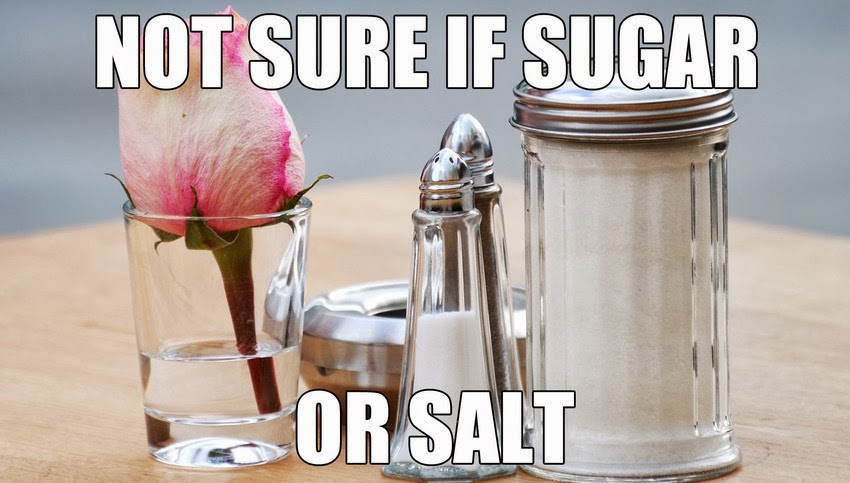 Heather Callaghan
Heather Callaghan
Activist Post
Great April Fools’ Day prank idea: Switch up your loved ones’ sugar with salt. When they spit out their coffee and comment on the saltiness you can insist that it’s really sugar and that there’s nothing wrong, giving the prank a twisted flair.
But you’d be right – because there’s friggin’ GMO sugar in salt!
This applies to ingredients found in iodized table salt, and should concern people who are serious about allergy-inducing ingredients or who are seeking a different eating style.
While getting a natural allergy treatment for sugar I had to avoid it completely for 25 hours. At least I can flavor food with salt, I said, but was told to check the label. Haha – okay – whatever. But no, it’s true – there was sugar!
There are a few reasons why sugar or corn-based dextrose is added to salt.
Sally Fallon explains in Nourishing Traditions:
Most discussions of salt ignore the issue of salt processing. Few people realize that our salt – like our sugar, flour and vegetable oils – is highly refined; it is the product of a chemical and high-temperature industrial process that removes all the valuable magnesium salts as well as trace minerals naturally occurring in the sea. To keep salt dry, salt refiners adulterate this “pure” product with several harmful additives, including aluminum compounds. To replace the natural iodine salts that are removed during processing, potassium iodide is added in amounts that can be toxic. To stabilize the volatile iodine compound, processors add dextrose which turns the iodized salt a purplish color. A bleaching agent is then necessary to restore whiteness to the salt… Even most so-called sea salt is produced by industrial methods. [emphasis added]
Many sources confirm that sugar or dextrose is added at 0.04 percent or 40 milligrams per 100 grams of salt to stabilize the potassium iodide, but are the anti-caking agents and added sugars worth the hassle of added iodine in salt? You decide. But to the person who can go into anaphylaxis from corn ingredients or those trying to avoid sugars and GMOs – it is not worth it.
There are three other, perhaps unwitting, reasons why this added dextrose benefits Big Food when it comes to salt. 1) it covers up the icky flavor of iodine. 2) It makes the salt taste even saltier to our taste buds. 3) It’s a cheap filler – yes, sugar is cheaper than salt – we can thank subsidies for that. So, if you wanted to run to salt while you eliminate other ingredients, iodized salt is not the way to go.
 When looking for salt please don’t be fooled by companies who are trying to look natural or claim to come from the sea. Nutritious unprocessed salt with naturally occurring trace minerals is not white! It doesn’t have added ingredients. It will be a different hue entirely, preferably pink or grey, and possibly brown or really off-white. If you want good iodine, add kelp while boiling dry beans – the beans will soak it up for you. Add kelp to soups as a way to “doctor” up your foods.
When looking for salt please don’t be fooled by companies who are trying to look natural or claim to come from the sea. Nutritious unprocessed salt with naturally occurring trace minerals is not white! It doesn’t have added ingredients. It will be a different hue entirely, preferably pink or grey, and possibly brown or really off-white. If you want good iodine, add kelp while boiling dry beans – the beans will soak it up for you. Add kelp to soups as a way to “doctor” up your foods.
Salt isn’t bad at all. Either get naturally occurring or non-iodized table salt (I know, horribly processed) but don’t stop eating it. A milestone JAMA study showed that people who don’t consume salt die younger from heart problems – and do you really think they used pink Himalayan natural salt for that study? Store it. Use a pinch in water to prevent heat stroke and dehydration.
I just don’t like supporting companies with extra $$$ that claim to be natural but aren’t and who add sugar, fillers and unnecessary preservatives. Salt IS the preservative and most of all it preserves YOU.
Heather Callaghan is a natural health blogger and food freedom activist. You can see her work at NaturalBlaze.com and ActivistPost.com. Like at Facebook.
Recent posts by Heather Callaghan:


Beware of BS.
“There are three other, perhaps unwitting, reasons why this added dextrose benefits Big Food when it comes to salt. 1) it covers up the icky flavor of iodine. 2) It makes the salt taste even saltier to our taste buds. 3) It’s a cheap filler – yes, sugar is cheaper than salt – we can thank subsidies for that. So, if you wanted to run to salt while you eliminate other ingredients, iodized salt is not the way to go.”
Facts: Many sources confirm that sugar or dextrose is added at 0.04 percent
That’s a pretty tiny amount. It means that with sugar being 3 calories per gram, you would need to eat… 2.5 kilograms of iodized salt to get ONE GRAM of sugar or nearly a full kilogram to get a single calorie from that sugar. If that’s not being needlessly alarmist, I don’t know what is. Yep, that’s maybe a half cup of salt to get ONE GRAIN of sugar.
Do you really think it makes a difference to the flavor? Really? I call BS on that.
Do you also really think that a substance used at 0.04% is being used as a… filler??? Please try to understand what a filler is and how it is used. Wheat is used as a filler for many things. Because it’s cheap and voluminous. Foods that use wheat as a filler can contain as much as 40% or more of wheat or constituents. 0.04% is *not* a filler.
What is that sugar *actually* for?
Turns out that it’s a stabilizer for the iodine. Iodine is a chemically volatile substance and is extremely important for our bodies as a trace mineral. Like many things that are important for our nutrition, this volatility makes it useful to our bodies. It also means that it can easily combine with other substances.
Vitamin C is often used in a similar way to stabilize substances that are quickly oxidized. If you’ve ever splashed some lemon juice on apple slices, you’ve done something similar.
So the sugar (usually dextrose) is used to stabilize the iodine to make sure it remains bio-available and carries the important anti-goiter nutrient into our digestive system.
Is it wrong that they use sugar to stabilize the iodine? Does sugar have a role in natural foods?
The answer is an affirmative YES!
Sugars and saccharides are used widely by *nature* to protect volatile oils from oxidization. Ancient societies frequently used sugars to protect oil-rich foods from oxidization. Walnuts are often coated in honey or other dried sugars to keep oxygen from turning the oils rancid. It is effective, natural and very beneficial.
But even this is not even in the same remote ballpark as adding 0.04% sugar to table salt.
Logic PLEASE!
Making salt by evaporating sea water (whether done now, or salt deposited millions of years ago) leaves behind more than just salt. There is also metals and other unhealthy junk.